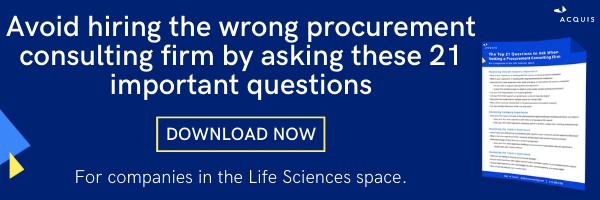Insight
Maximizing ROI Through Strategic Sourcing and Procurement
Rushing into contracts with new vendors or maintaining suboptimal agreements with current vendors is dangerous for your organization. Not only can these actions jeopardize the quality of the materials and products your organization has access to, but failing to improve your processes now leads to hours of wasted time in the future.
There are also growing risks of supply chain turbulence around the world. In fact, according to QAD, “One of the top risk priorities for sourcing and procurement organizations continues to be ensuring business continuity by avoiding disruptions with key suppliers.”
If your organization’s sourcing and procurement processes are opaque or you know there’s underlying waste, it’s time to create a new approach. Learn more about the differences between strategic sourcing and procurement — and how focusing on these two concepts will benefit your entire organization.
How Strategic Sourcing and Procurement Coexist
Strategic sourcing and procurement are two sides of the same coin; they both play a role in the entire source-to-pay process. But it’s important to understand the differences between the two (as well as how they relate) before you start finalizing your strategies. At its core, strategic sourcing is all about finding the right vendors with the right pricing, and procurement is the process you follow to use your vendor contracts and order goods.
What Is Strategic Sourcing?
Sourcing is how you determine which vendors and supplies you need from a big-picture perspective. You and your team will assess different vendors based on factors like their reliability, capabilities, and pricing. Then you’ll contract with the suppliers or vendors that fit your standards to create agreements that suit your business plan and customers. All of this lays the framework for the procurement process.
What Is Procurement?
Procurement is at the heart of your company’s supply chain. During the procurement process, you and your team place and confirm orders, pay for them, and receive the orders.
Complex supply chains will have various stages of inspecting the order, checking its progress in real-time, and assessing what goods are needed. Procurement is the act of purchasing and receiving goods or services from the vendors you chose during strategic sourcing.
How Do They Interact?
Without strategic sourcing, your procurement processes will be disorganized, costly, and hard to manage — your team will simply purchase goods from unknown vendors. Without procurement, the contracts you researched and negotiated fail. These two processes work together to ensure your organization is receiving optimal quality, pricing, and efficiency with every order so your cash flow can be directed towards growth.
Maximizing ROI With Sourcing and Procurement Strategy
Putting in the strategic prep work to have more strategic sourcing and clear-cut procurement processes is crucial to making your organization stronger. You can streamline your procurement processes to achieve less downtime and better customer satisfaction.
You gain transparency into your organization’s spending and have better relationships with your vendors. Ultimately, you can maximize your return on investment with these five core benefits:
SG&A Cost Reduction
Sales, general, and administration (SGA) expenses make up a large portion of your company’s overhead. While purchases are necessary to keep your company going, too many expenses (or expenses that are too costly) can limit your company’s profits and opportunities for growth.
You can streamline purchasing processes with more cost-effective prices and less administrative waste. Large organizations and interdepartmental groups may struggle with SG&A cost reduction because there aren’t clear routes to manage it. But better sourcing and smart procurement make it easier to identify low-hanging fruit for cost reduction.
Contract Compliance
Procurement only manages a portion of a company’s total spend. Failing to comply and stay within that threshold puts the whole organization at financial risk. Over- and under-ordering can also complicate vendor relationships, as vendors fail to see the expected sales based on your agreement or are put under undue pressure for unpredictable orders.
But strategic sourcing and procurement processes — especially data-based, integrated processes — make it easier for organizations to optimize contracts without stressing the relationship or falling outside of the budget.
Staying compliant with your vendor contracts has both direct and indirect benefits for your bottom line. Directly, you don’t incur fees or penalties that may be outlined in the agreement for compliance failure. Indirectly, you can maintain (or even grow) discounts your vendors may be willing to grant based on reliable purchasing and invoice payment.
Aligning Spend to ESG
Environmental, social, and corporate governance (ESG) is more important than ever for organizations in every sector and industry. Organizations increasingly need to assess their positive and negative impacts in social and environmental contexts.
Excess waste, procuring goods from known polluters, and supporting companies with poor social track records doesn’t just fail to align your employees and mission with positive principles; it can jeopardize your relationship with your customers and other organizations.
If you implement strategic sourcing initiatives, you can carefully evaluate your vendors to find the best fit for your bottom line and your ESG concerns rather than rush to a decision. When you align your spend based on ESG initiatives, you can also ensure your organization can fund ongoing projects and improvements.
Business Continuity Planning
Fluctuations in the supply chain are always nerve-racking for businesses. COVID-19 made many companies unstable due to supply shortages, delivery delays, and sudden changes in pricing or availability. Relying on just one supplier is dangerous, and it will continue to be dangerous.
During your sourcing processes, it’s important to identify several potential partners that you can contract with to create backup plans and diverse supply chain pathways so shortages don’t disproportionately impact your business and customers. The more diverse your supply base, the more stable your business will be in the face of turbulence.
Process Efficiency
The right tools and processes will cut down on actual inefficiencies in your internal processes, not just the downstream supply chain. By making your processes more efficient now, you create SOPs for future contract negotiations and procurement cycles. You create repeatable strategies that can be used as your organization grows and changes.
Even better, you can automate the procurement process for faster, more accurate orders.
Work With Acquis Consulting to Maximize Your ROI
Smarter sourcing and procurement practices start with data. By analyzing your current processes and needs, you can identify the most impactful changes that will maximize your ROI.
At Acquis Consulting, we specialize in helping organizations identify areas of growth and stronger processes within their own organization. Contact us today to learn more about our capabilities and strengthen your sourcing and procurement processes.






